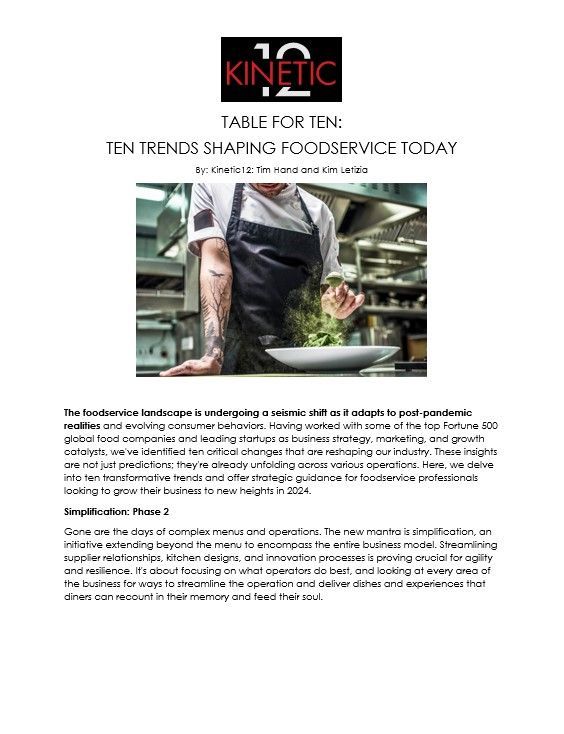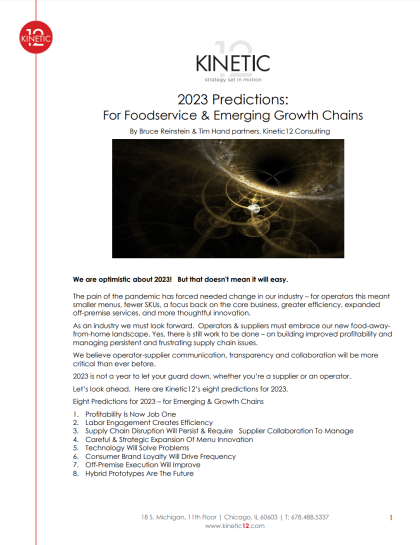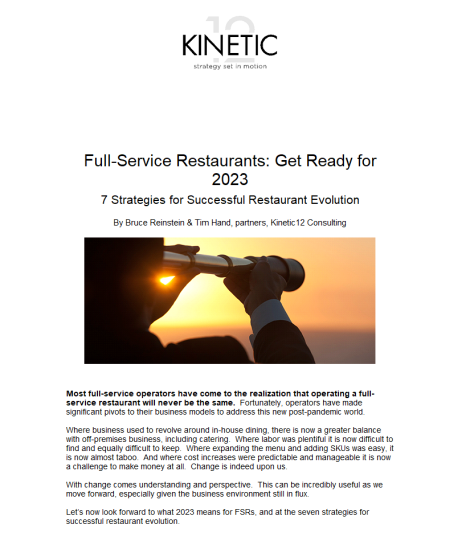The Clock Is Ticking: Why Foodservice Manufacturers Must Act Now
The Foodservice Landscape Has Changed—Permanently
The U.S. foodservice industry is entering a period of structural transformation. While foodservice continues to outperform retail in recent months, total channel growth in 2025 is projected at only +0.9% and +1.1% for 2026, according to IFMA Scope.
This slow growth environment masks deeper turbulence. Economic uncertainty continues to weigh on the consumer, restaurant traffic is uneven, on-site dining is showing limited gains, and rising costs put pressure on everyone’s bottom line.
For manufacturers, the conclusion is unavoidable:
the growth playbooks of the last decade no longer work. Success now depends on strategic focus, sharper execution and disciplined investment.
Sustained Revenue Growth Is Harder to Find
Market realities are shifting for foodservice manufacturers. Despite solid execution, many sales leaders are facing flat or declining sales as restaurant traffic continues to soften across much of the industry. Yet expectations for growth remain high, forcing teams to be more deliberate about where and how they compete.
In established segments, growth is now a share game. Winning requires a precise understanding of operators’ evolving needs and a clear view of how your brand stacks up against competitors. Sales organizations that leverage their strengths, close capability gaps, and align their value proposition to customer priorities are best positioned to outperform.
At the same time, a number of segments offer pathways to growth. Convenience stores, for example, are projected to grow more than twice as fast as restaurants in 2025 (+1.5% vs. +0.7%, IFMA Scope). Office feeding, travel & leisure and healthcare segments are also projected to grow at above-market levels. Targeting these faster-growing segments can unlock meaningful whitespace opportunities for manufacturers ready to diversify their focus.
The path forward requires focus and agility. Sales leaders must:
- Focus resources on the highest-return segments and customers.
- Refine positioning continuously to capture share in mature markets.
- Invest strategically in emerging channels with sustained growth potential.
Long-term success will favor manufacturers that
balance share capture in mature markets with bold expansion into emerging ones.
Margins Are Shrinking Under Structural Pressure
Public filings from leading food and beverage companies show a clear pattern – profitability is eroding. The costs related to getting product to the operator have continued to increase as we have seen an increase in fees and fines while group purchasing organizations continue to expand.
Meanwhile, operator and consumer tolerance for price increases has declined, forcing manufacturers to absorb more costs. A 2025 Kinetic 12 SalesLAB™ survey found that 0perator and distributor investment, in the form of trade spending and discounting, has rising to more than 20%, yet volume growth has not kept pace. The path forward requires discipline and transparency. Manufacturers must:
- Reestablish ROI visibility by quantifying the financial impact of all customer investments
- Rationalize partnerships to eliminate relationships that do not drive strategic or financial value
- Shift pricing strategy from pass-through increases to differentiated, data-driven value creation
In short, it’s time to take back control of your P&L.
Technology Adoption Is Now a Competitive Imperative
The pace of digital transformation in foodservice has reached an inflection point. Operators’ top investment priority, according to the Kinetic12 Q2 2025 Emergence™ Survey, is now technology and automation.

Manufacturers cannot remain on the sidelines. Digital systems are now the backbone of modern sales, marketing, and supply chain execution. Yet many manufacturers still rely on fragmented legacy tools, lack centralized data visibility and struggle to turn insights into decisions. Sales leaders should no longer think of technology as a tool to report sales and marketing activity but as a key driver of incremental sales and margin.
To remain competitive, manufacturers should:
- Modernize core systems and invest in data integration to enable real-time sales, margin, and supply chain visibility
- Use data analytics to identify channel inefficiencies and incremental sales opportunities
- Build internal technology and data fluency, ensuring teams can interpret and act on digital intelligence, not just collect it
- Test AI to increase the efficiency and effectiveness of your sales and marketing efforts
In a market where speed and precision define advantage,
those who fail to evolve technologically risk being outpaced.
Leadership Must Reorient Around Agility and Reinvention
Traditional management skills focused on steady-state operations are being replaced by a demand for turnaround and transformation leadership. Executives must lead through uncertainty, not avoid it.
Manufacturers should take immediate steps to:
- Re-evaluate strategy and structure for alignment with new market realities
- Diversify growth avenues, including new segments such as convenience, retail/grocerants, micro-markets/new-age vending and emerging commercial chains
- Reinvest in people and skills along with technology, emphasizing digital, analytical and cross-functional expertise
- Foster a culture of continuous experimentation, rewarding adaptation and speed over legacy process
The industry’s evolution is no longer cyclical—it’s structural.
Manufacturers that treat this moment as a pause will be overtaken by those that treat it as a pivot.
Manufacturers that treat this moment as a pause will be overtaken by those that treat it as a pivot.
The Window for Action Is Narrow and Right Now
The next year will define the next decade for food manufacturers. Those who act decisively – by restoring control over cost structures, building data intelligence, and retooling operations for agility – will emerge stronger. Those who hesitate risk watching their sales and margins continue to erode.
Now is the time to reset, reinvest, and reimagine.
Kinetic12’s SalesLAB™ helps foodservice manufacturers regain control of their business by helping them optimize go-to-market strategy and accelerate sales performance. SalesLAB™ members participate in the industry’s only sales benchmarking survey built to measure and optimize customer investment, and can also participate in the SalesLAB™ Performance Group, a peer group of foodservice leaders collaborating to turn insights into action – solving industry issues, improving decisions and advancing new thinking.
Visit
https://www.kinetic12.com/sales-lab for more information.
Art Bell, Jennifer Brizzolara and Rob Veidenheimer are with Kinetic12, specializing in combining business strategy, sales optimization, and marketing communications that accelerate growth through powerful, collaborative partnerships within the foodservice industry.
Kinetic12, is a Chicago-based foodservice and general management consulting firm. The firm works with leading foodservice suppliers, operators, and organizations on customized strategic initiatives, marketing communications, and culinary sales and innovation, as well as guiding multiple collaborative forums and best practice projects. They also engage as keynote speakers at operator franchise conferences and supplier sales meetings. Their previous leadership roles in restaurant chain operations and at foodservice manufacturers provide a balanced industry perspective.
Contact us to learn more about how we can help your organization through customized consulting, sales benchmarking, culinary & marketing, or through participating in our Collaborative Innovation and Emerging & Growth Chains programs.



